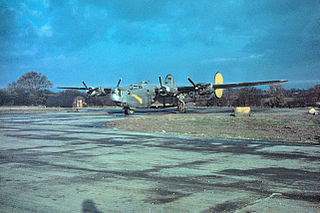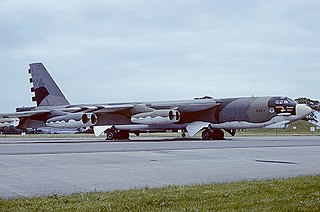
The 416th Air Expeditionary Wing (AEW) is a provisional unit assigned to the Air Combat Command of the United States Air Force to activate or inactivate as needed.

The 417th Bombardment Group is an inactive United States Army Air Forces unit. Its last assignment was with V Bomber Command at Itami Airfield, Japan, where it was inactivated on 5 November 1945.

The 673d Bombardment Squadron is an inactive United States Army Air Forces unit. Its last assignment was with the 417th Bombardment Group at Itami Airfield, Japan, where it was inactivated on 5 November 1945.

The 847th Bombardment Squadron is a former United States Army Air Forces unit that was originally activated as the 421st Bombardment Squadron. Its last assignment was with the 489th Bombardment Group at Great Bend Army Air Field, Kansas where it was inactivated on 28 March 1945. As the 20th Antisubmarine Squadron, the squadron performed antisubmarine patrols in 1942 and 1943. After reforming as a heavy bomber squadron, it engaged in the strategic bombing campaign against Germany in the European Theater of Operations until returning to the United States in late 1944. The squadron was inactivated while its parent group was training as a very heavy bombardment unit.

The 859th Bombardment Squadron is a former United States Army Air Forces unit. it was first activated in October 1942 as the 517th Bombardment Squadron, when the Army Air Forces replaced National Guard observation units that had been mobilized and were performing antisubmarine patrols off the Atlantic coastline. A month after its activation, the squadron was redesignated the 12th Antisubmarine Squadron. In August 1943, the Army Air forces began turning the antisubmarine patrol mission over to the Navy and the squadron moved to California, where, as the 859th Bombardment Squadron, it formed the cadre for the 492d Bombardment Group.

The 835th Bombardment Squadron is an inactive United States Army Air Forces unit. It was activated in January 1941 as the 80th Bombardment Squadron and equipped with Douglas A-20 Havoc light bombers. Following the attack on Pearl Harbor the squadron began to fly antisubmarine patrols off the Atlantic coast and over the Caribbean Sea, becoming the 9th Antisubmarine Squadron.

The 514th Fighter-Interceptor Squadron is an inactive United States Air Force unit. Its last assignment was with the 86th Air Division, based at Ramstein Air Base, Germany, where it was inactivated on 8 January 1961.

The 644th Bomb Squadron is an inactive United States Air Force unit. It was last assigned to the 410th Bombardment Wing at K. I. Sawyer Air Force Base, Michigan, where it was inactivated on 21 November 1994.

The 668th Bomb Squadron is an inactive United States Air Force unit. It was last assigned to the 416th Operations Group at Griffiss Air Force Base, New York, where it was inactivated on 1 January 1995.

The 670th Bombardment Squadron is a former United States Army Air Forces unit, assigned to the 416th Bombardment Group. The squadron was activated a medium bomber unit during World War II. It trained in the United States before deploying to the European Theater of Operations, where it served with Ninth Air Force. It moved to the continent of Europe following D-Day and continued operations until the end of the war, earning a Distinguished Unit Citation for its actions in combat. It returned to the United States in the fall of 1945 and was inactivated at the Port of Embarkation.

The 647th Bombardment Squadron is a former United States Army Air Forces unit, activated during World War II. The squadron moved to the European Theater of Operations in the spring of 1944. It flew air support and air interdiction missions with Douglas A-20 Havoc bombers, first from England, then from Advanced Landing Grounds on the European continent. It received a Distinguished Unit Citation for missions flown against German targets during the Battle of the Bulge. In February 1945, the unit began converting to the Douglas A-26 Invader, but the war ended before it flew any combat missions with its new aircraft. It returned to the United States in the summer of 1945 and was inactivated at Myrtle Beach Army Air Field, South Carolina on 7 November 1945.

The 646th Bombardment Squadron is a former United States Army Air Forces unit, activated during World War II. The squadron moved to the European Theater of Operations in the spring of 1944. It flew air support and air interdiction missions with Douglas A-20 Havoc bombers, first from England, then from Advanced Landing Grounds on the European continent. It received a Distinguished Unit Citation for missions flown against German targets during the Battle of the Bulge. In February 1945, the unit began converting to the Douglas A-26 Invader, but the war ended before it flew any combat missions with its new aircraft. It returned to the United States in the summer of 1945 and was inactivated at Myrtle Beach Army Air Field, South Carolina on 7 November 1945.

The 645th Bombardment Squadron is a former United States Army Air Forces unit, activated during World War II. The squadron moved to the European Theater of Operations in the spring of 1944. It flew air support and air interdiction missions with Douglas A-20 Havoc bombers, first from England, then from Advanced Landing Grounds on the European continent. It received a Distinguished Unit Citation for missions flown against German targets during the Battle of the Bulge. In February 1945, the unit began converting to the Douglas A-26 Invader, but the war ended before it flew any combat missions with its new aircraft. It returned to the United States in the summer of 1945 and was inactivated at Myrtle Beach Army Air Field, South Carolina on 7 November 1945.

The 839th Bombardment Squadron is an inactive United States Army Air Forces unit. It was activated in January 1941 as the 79th Bombardment Squadron and equipped with Douglas A-20 Havoc light bombers. Following the attack on Pearl Harbor the squadron began to fly antisubmarine patrols off the Atlantic coast and over the Caribbean Sea, becoming the 8th Antisubmarine Squadron.

The 640th Bombardment Squadron is an inactive United States Army Air Forces unit. After training with Douglas A-20 Havocs in the United States the squadron deployed to the European Theater of World War II, where it engaged in combat until the Surrender of Germany. It was last assigned to the 409th Bombardment Group at Westover Field, Massachusetts, where it was inactivated on 7 November 1945.

The 642d Bombardment Squadron is an inactive United States Army Air Forces unit. After training with Douglas A-20 Havocs in the United States the squadron deployed to the European Theater of World War II, where it engaged in combat until the Surrender of Germany. It was last assigned to the 409th Bombardment Group at Westover Field, Massachusetts, where it was inactivated on 7 November 1945.

The 643d Bombardment Squadron is an inactive United States Army Air Forces unit. After training with Douglas A-20 Havocs in the United States the squadron deployed to the European Theater of World War II, where it engaged in combat until the Surrender of Germany. It was last assigned to the 409th Bombardment Group at Westover Field, Massachusetts, where it was inactivated on 7 November 1945.

The 30th Tactical Missile Squadron is an inactive United States Air Force unit. In 1985 the squadron was formed by combining three United States Air Force and Army Air Forces units that had served in World War II and the Cold War into a single unit with a common heritage. However, the combined unit has not since been active.

The 573d Tactical Air Support Squadron is an inactive United States Air Force unit. It was formed by the consolidation of two earlier units bearing the number 573, but has not been active since the consolidation.

The 323d Expeditionary Operations Group is a provisional United States Air Force unit assigned to the United States Air Forces in Europe. As a provisional unit, it may be activated or inactivated at any time.






















